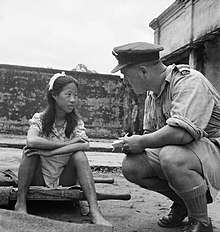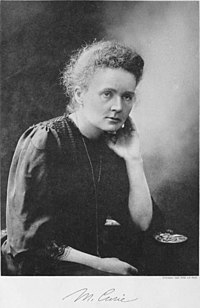Woman
A woman /ˈwʊmən/, pl: women /ˈwɪmɨn/ is a female human. The term woman is usually reserved for an adult, with the term girl being the usual term for a female child or adolescent. However, the term woman is also sometimes used to identify a female human, regardless of age, as in phrases such as "women's rights". Women are typically capable of giving birth from puberty onwards, though older women who have gone through menopause and some intersex women cannot. Throughout history women have assumed various social roles in occupation. In some cultures, a majority of women have adopted specific appearances, such as those regulated by dress codes.Etymology
The spelling of woman in English has progressed over the past millennium from wīfmann[1] to wīmmann to wumman, and finally, the modern spellingwoman.[2] In Old English, wīfmann meant "female human", whereas wēr meant "male human". Mann or monn had a gender-neutral meaning of "human", corresponding to Modern English "person" or "someone", however subsequent to the Norman Conquest, man began to be used more in reference to "male human", and by the late 1200s had begun to eclipse usage of the older term wēr.[3] The medial labial consonants f and m in wīfmann coalesced into the modern form "woman", while the initial element, which meant "female", underwent semantic narrowing to the sense of a married woman ("wife"). It is a popular misconception that the term "woman" is etymologically connected with "womb", which is from a separate Old English word, wambe meaning "stomach" (of male or female). Nevertheless, such a false derivation of "woman" has appeared in print.[4]
A very common Indo-European root for woman, *gwen-, is the source of modern English "queen" (Old English cwēn had primarily meant woman, highborn or not; this is still the case in Danish, with the modern spelling kvinde, as well as in Swedish kvinna and Norwegian kvinne). The word gynaecology is also derived from the Ancient Greek cognate γυνή gynē, woman. Other English words traceable to the same Indo-European root include banshee "fairy woman" (from Irish bean "woman" and sí "fairy") and zenana (from Persian زن zan).[5]
The Latin fēmina, whence female, is likely from the root in fellāre (to suck), in reference to breastfeeding.
Womanhood is the period in a female's life after she has passed through childhood and adolescence, generally around the age 18.
The word woman can be used generally, to mean any female human, or specifically, to mean an adult female human as contrasted with girl. The wordgirl originally meant "young person of either sex" in English;[7] it was only around the beginning of the 16th century that it came to mean specifically afemale child.[8] The term girl is sometimes used colloquially to refer to a young or unmarried woman, however during the early 1970s feminists challenged such use because the use of the word to refer to a fully grown woman may cause offence. In particular, previously common terms such asoffice girl are no longer widely used. Conversely, in certain cultures which link family honor with female virginity, the word girl is still used to refer to a never-married woman; in this sense it is used in a fashion roughly analogous to the obsolete English maid or maiden. Referring to an unmarried female human as a woman may, in such a culture, imply that she is sexually experienced, which would be an insult to her family.
There are various words used to refer to the quality of being a woman. The term "womanhood" merely means the state of being a woman, having passed the menarche; "femininity" is used to refer to a set of typical female qualities associated with a certain attitude to gender roles; "womanliness" is like "femininity", but is usually associated with a different view of gender roles; "femaleness" is a general term, but is often used as shorthand for "human femaleness"; "distaff" is an archaic adjective derived from women's conventional role as a spinner, now used only as a deliberate archaism; "muliebrity" is a neologism (derived from the Latin) meant to provide a female counterpart of "virility", but used very loosely, sometimes to mean merely "womanhood", sometimes "femininity" and sometimes even as a collective term for women.
Menarche, the onset of menstruation, occurs on average at age 12-13. Many cultures have rites of passage to symbolize a girl's coming of age, such as confirmation in some branches ofChristianity, bat mitzvah in Judaism, or even just the custom of a special celebration for a certain birthday (generally between 12 and 21), like the Quinceañera of Latin America.
History
The earliest women whose names are known through archaeology include:
- Neithhotep (circa 3,200 B.C.E.), the wife of Narmer and the first queen of ancient Egypt.[9][10]
- Merneith (circa 3,000 B.C.E.), consort and regent of ancient Egypt during the first dynasty. She may have been ruler of Egypt in her own right.[11][12]
- Merit-Ptah (circa 2,700 B.C.E.), also lived in Egypt and is the earliest known female physician and scientist.[13]
- Peseshet (circa 2,600 B.C.E.), a physician in Ancient Egypt.[14][15]
- Puabi (circa 2,600 B.C.E.), or Shubad – queen of Ur whose tomb was discovered with many expensive artifacts. Other known pre-Sargonic queens of Ur (royal wives) include Ashusikildigir, Ninbanda, and Gansamannu.[16]
- Kugbau (circa 2,500 B.C.E.), a taverness from Kish chosen by the Nippur priesthood to become hegemonic ruler of Sumer, and in later ages deified as "Kubaba"
- Tashlultum (circa 2,400 B.C.E.), Akkadian queen, wife of Sargon of Akkad and mother of Enheduanna.[17][18]
- Baranamtarra (circa 2,384 B.C.E.), prominent and influential queen of Lugalanda of Lagash. Other known pre-Sargonic queens of the first Lagash dynasty include Menbara-abzu, Ashume'eren, Ninkhilisug, Dimtur, and Shagshag, and the names of several princesses are also known.
- Enheduanna (circa 2,285 B.C.E.),[19][20] the high priestess of the temple of the Moon God in the Sumerian city-state of Ur and possibly the first poet and first named author of either gender.
Health
Further information: Women's health and Maternal deathWomen's health refers to health issues specific to human female anatomy. There are some diseases that primarily affect women, such as lupus. Also, there are some sex-related illnesses that are found more frequently or exclusively in women, e.g., breast cancer, cervical cancer, or ovarian cancer. Women and men may have different symptoms of an illness and may also respond differently to medical treatment. This area of medical research is studied by gender-based medicine.Maternal mortality or maternal death is defined by WHO as "the death of a woman while pregnant or within 42 days of termination of pregnancy, irrespective of the duration and site of the pregnancy, from any cause related to or aggravated by the pregnancy or its management but not from accidental or incidental causes."[29] About 99% of maternal deaths occur in developing countries. More than half of them occur in sub-Saharan Africaand almost one third in South Asia. The main causes of maternal mortality are severe bleeding (mostly bleeding after childbirth), infections (usually after childbirth), pre-eclampsia and eclampsia, unsafe abortion, and pregnancy complications from malaria and HIV/AIDS.[30] Most European countries, Australia, as well as Japan and Singapore are very safe in regard to childbirth, while Sub-Saharan countries are the most dangerous.Culture and gender roles
Main article: Gender roleIn many prehistoric cultures, women assumed a particular cultural role. In hunter-gatherer societies, women were generally the gatherers of plant foods, small animal foods and fish, while men hunted meat from large animals.In more recent history, the gender roles of women have changed greatly. Traditionally, middle class women were involved in domestic tasks emphasizing child care. For poorer women, especially working class women, although this often remained an ideal,[specify] economic necessity compelled them to seek employment outside the home. The occupations that were available to them were, however, lower in pay than those available to men.As changes in the labor market for women came about, availability of employment changed from only "dirty", long hour factory jobs to "cleaner", more respectable office jobs where more education was demanded, women's participation in the U.S. labor force rose from 6% in 1900 to 23% in 1923. These shifts in the labor force led to changes in the attitudes of women at work, allowing for the revolution which resulted in women becoming career and education oriented.In the 1970s, many female academics, including scientists, avoided having children. However, throughout the 1980s, institutions tried to equalize conditions for men and women in the workplace. However, the inequalities at home stumped women's opportunities to succeed as far as men. Professional women are still responsible for domestic labor and child care. As people would say, they have a "double burden" which does not allow then the time and energy to succeed in their careers. Furthermore, though there has been an increase in the endorsement of egalitarian gender roles in the home by both women and men, a recent research study showed that women focused on issues of morality, fairness, and well-being, while men focused on social conventions.[39] Until the early twentieth century, U.S. women's colleges required their women faculty members to remain single, on the grounds that a woman could not carry on two full-time professions at once. According to Schiebinger, "Being a scientist and a wife and a mother is a burden in society that expects women more often than men to put family ahead of career." (pg. 93).[40]Movements advocate equality of opportunity for both sexes and equal rights irrespective of gender. Through a combination of economic changes and the efforts of the feminist movement,[specify] in recent decades women in many societies now have access to careers beyond the traditionalhomemaker.Although a greater number of women are seeking higher education, salaries are often less than those of men. CBS News claims that in the United States women who are ages 30 to 44 and hold a university degree make only 62 percent of what similarly qualified men do, a lower rate than in all but three of the 19 countries for which numbers are available. Some Western nations with greater inequity in pay are Germany, New Zealand and Switzerland.[41]Violence against women
Main article: Violence against womenThe phrase violence against women is a technical term used to collectively refer to violent acts that are committed against women, especially when said violence is committed because of their gender, or when it affects women disproportionately.The UN Declaration on the Elimination of Violence against Women defines "violence against women" as:[42]- "any act of gender-based violence that results in, or is likely to result in, physical, sexual or mental harm or suffering to women, including threats of such acts, coercion or arbitrary deprivation of liberty, whether occurring in public or in private life."
and identifies three forms of such violence: that which occurs in the family, that which occurs within the general community, and that which is perpetrated or condoned by the State. It also states that "violence against women is a manifestation of historically unequal power relations between men and women".[43]Violence against women remains a widespread problem, fueled, especially outside the West, by patriarchal social values, lack of adequate laws, and lack of enforcement of existing laws. Social norms that exist in many parts of the world hinder progress towards protecting women from violence. For example, according to surveys by UNICEF, the percentage of women aged 15–49 who think that a husband is justified in hitting or beating his wife under certain circumstances is as high as 90% in Afghanistan and Jordan, 87% in Mali, 86% in Guinea and Timor-Leste, 81% in Laos, and 80% in the Central African Republic.[44] A 2010 survey conducted by the Pew Research Center found that stoning as a punishment for adultery was supported by 82% of respondents in Egypt and Pakistan, 70% in Jordan, 56% Nigeria, 42% in Indonesia.[45]Specific forms of violence that affect women include female genital mutilation, sex trafficking, forced prostitution, forced marriage, rape, sexual harassment, honor killings, acid throwing, dowry related violence. The State can be complicit in violence against women, for instance through practices such as stoning (as punishment for adultery).There have also been many forms of violence against women which have been prevalent historically, notably the burning of witches, the sacrifice ofwidows (such as sati) and foot binding. The prosecution of women accused of witchcraft has a long tradition, for example witch trials in the early modern period (between the 15th and 18th centuries) were common in Europe and in the European colonies in North America. Today, there remain regions of the world (such as parts of Sub-Saharan Africa, rural North India, and Papua New Guinea) where belief in witchcraft is held by many people, and women accused of being witches are subjected to serious violence.[46][47][48] In addition, there are also countries which have criminal legislation against the practice of witchcraft. In Saudi Arabia, witchcraft remains a crime punishable by death, and in 2011 the country beheaded a woman for 'witchcraft and sorcery'.[49][50]It is also the case that certain forms of violence against women have been recognized as criminal offenses only during recent decades, and are not universally prohibited, in that many countries continue to allow them. This is especially the case with marital rape.[51][52] In the Western World, there has been a trend towards ensuring gender equality within marriage and prosecuting domestic violence, but in many parts of the world women still lose significant legal rights when entering a marriage.[53]Sexual violence against women greatly increases during times of war and armed conflict, during military occupation, or ethnic conflicts; most often in the form of war rape and sexual slavery. Contemporary examples of sexual violence during war include rape during the Bangladesh Liberation War, rape in the Bosnian War, rape during the Rwandan Genocide, and rape during Second Congo War. In Colombia, the armed conflict has also resulted in increased sexual violence against women.[54]Laws and policies on violence against women vary by jurisdiction. In the European Union, sexual harassment and human trafficking are subject todirectives.[55][56]Clothing, fashion and dress codes
Women in different parts of the world dress in different ways, with their choices of clothing being influenced by local culture and traditions, social norms, and fashion trends. Different societies have different ideas about modesty. However, in many jurisdictions, women's choices in regard to dress are not always free, with laws limiting what they may or may not wear. This is especially the case in regard to Islamic dress. While certain jurisdictions legally mandate such clothing (the wearing of the headscarf), other countries forbid or restrict the wearing of certain hijab attire (such as burqa/covering the face) in public places (one such country is France - see French ban on face covering). These laws are highly controversial.[57]Fertility and family life
Further information: MotherThe total fertility rate (TFR) - the average number of children born to a woman over her lifetime - differs significantly between different regions of the world. In 2013, the highest estimated TFR was in Niger (7.03 children born per woman) and the lowest in Singapore (0.79 children/woman).[59] While most Sub-Saharan African countries have a high TFR, which creates problems due to lack of resources and contributes to overpopulation, most Western countries currently experience a sub replacement fertility rate which may lead to population ageing and population decline.In many parts of the world, there has been a change in family structure over the past few decades. For instance, in the West, there has been a trend of moving away from living arrangements that include the extended family to those which only consist of the nuclear family. There has also been a trend to move from marital fertility to non-marital fertility. Children born outside marriage may be born to cohabiting couples or to single women. While births outside marriage are common and fully accepted in some parts of the world, in other places they are highly stigmatized, with unmarried mothers facing ostracism, including violence from family members, and in extreme cases even honor killings.[60][61] In addition, sex outside marriage remains illegal in many countries (such as Saudi Arabia, Pakistan,[62] Afghanistan,[63][64] Iran,[64] Kuwait,[65] Maldives,[66] Morocco,[67] Oman,[68] Mauritania,[69] United Arab Emirates,[70][71] Sudan,[72] Yemen,[73]).The social role of the mother differs between cultures. In many parts of the world, women with dependent children are expected to stay at home and dedicate all their energy to child raising, while in other places (mostly in Western countries) mothers most often return to paid work (see working motherand stay at home mother).Religion
Further information: Women in Christianity, Women in Judaism, Women in Islam, Women in Mormonism, Women in Hinduism, Women in Sikhism, and Women in BuddhismParticular religious doctrines have specific stipulations relating to gender roles, social and private interaction between the sexes, appropriate dressing attire for women, and various other issues affecting women and their position in society. In many countries, these religious teachings influence the criminal law, or the family law of those jurisdictions. (see for example Sharia law). The relation between religion, law and gender equality has been discussed by international organizations.[74]Education
Main article: Female educationLiteracy
Main article: LiteracyWorld literacy is lower for females than for males. Latest data from CIA World Factbook shows that 79.7% of women are literate, compared to 88.6% of men (aged 15 and over). Literacy rates are lowest in South and West Asia, and in parts of Sub-Saharan Africa.[75]OECD countries
Education
The educational gender gap in Organisation for Economic Co-operation and Development (OECD) countries has been reduced over the last 30 years. Younger women today are far more likely to have completed a tertiary qualification: in 19 of the 30 OECD countries, more than twice as many women aged 25 to 34 have completed tertiary education than have women aged 55 to 64. In 21 of 27 OECD countries with comparable data, the number of women graduating from university-level programmes is equal to or exceeds that of men. 15-year-old girls tend to show much higher expectations for their careers than boys of the same age.[76]While women account for more than half of university graduates in several OECD countries, they receive only 30% of tertiary degrees granted in science and engineering fields, and women account for only 25% to 35% of researchers in most OECD countries.[77]There is a common misconception that women have still not advanced in achieving academic degrees. According to Margaret Rossiter, ahistorian of science, women now earn 54 percent of all bachelor's degrees in the United States. However, although there are more women holding bachelors degrees than men, as the level of education increases, the more men tend to fit the statistics instead of women. At thegraduate level, women fill 40 percent of the doctorate degrees (31 percent of them being in engineering).[78]While to this day women are studying at prestigious universities at the same rate as men, they are not being given the same chance to join faculty. Sociologist Harriet Zuckerman has observed that the more prestigious an institute is, the more difficult and time consuming it will be for women to obtain a faculty position there. In 1989, Harvard University tenured its first woman in chemistry, Cynthia Friend, and in 1992 its first woman in physics, Melissa Franklin. She also observed that women were more likely to hold their first professional positions as instructors and lecturers while men are more likely to work first in tenure positions. According to Smith and Tang, as of 1989, 65 percent of men and only 40 percent of women held tenured positions and only 29 percent of all scientists and engineers employed as assistant professors in four-year colleges and universities were women.[79]Jobs
In 1992, women earned 9 percent of the Ph.D.'s awarded in engineering but only one percent made it to become a professor. In 1995, 11 percent of professors in science and engineering were women. In relation, only 311 deans of engineering schools were women, which is less than 1 percent of the total. Even inpsychology, a degree in which women earn the majority of Ph.D.'s, they hold a significant amount of fewer tenured positions, roughly 19 percent in 1994.[80]Women in politics
Politics have been traditionally dominated by men; and women today continue to be under-represented in government in most countries. On October 2013, the global average of women in national assemblies was 21.5%.[82]Suffrage is the civil right to vote. Women's suffrage in the United States was achieved gradually, first at state and local levels, starting in the late 19th century and early 20th century, and in 1920 women in the US received universal vote, with the passage of the Nineteenth Amendment to the United States Constitution. Some Western countries were slow to allow women to vote; notably Switzerland, where women gained the right to vote in federal elections in 1971, and in the canton of Appenzell Innerrhoden women were granted the right to vote on local issues only in 1991, when the canton was forced to do so by the Federal Supreme Court of Switzerland;[83][84] andLiechtenstein, in 1984, through the Liechtenstein women's suffrage referendum, 1984.Science, literature and art
Women have, throughout history, made contributions to science, literature and art. One area where women have been permitted most access historically was that of obstetrics and gynecology (prior to the 18th century, caring for pregnant women in Europe was undertaken by women; from the mid 18th century onwards medical monitoring of pregnant women started to require rigorous formal education, to which women did not generally have access, therefore the practice was largely transferred to men).[85][86]Writing was generally also considered acceptable for upper class women, although achieving success as a female writer in a male dominated world could be very difficult; as a result several women writers adopted a male pen-name (e.g. George Sand, George Eliot).
















No comments:
Post a Comment